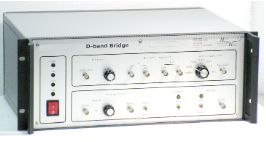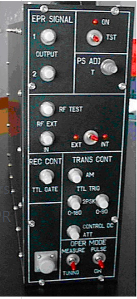Elva-1 94 GHz and 130 GHz Transceiver Units for EPR ODMR Spectrometers
See full specification tab below or
Electron paramagnetic resonance (EPR) is widely used in research in the fields of chemistry, biophysics, medicine, as well as
in solid-state physics, semiconductor physics, and the physics of nanostructures. The current trend is to increase the operating frequency of ESR spectrometers, which greatly improves the sensitivity and spectral resolution. The use of optically detected magnetic resonance (ODMR) makes it possible to combine high energy resolution and EPR information value with the advantages of optical spectroscopy, such as high sensitivity and spatial selectivity. The EPR ODMR spectrometer allows for the study of the excited state of the sample and can be used effectively for research and diagnosis of nanostructures.
The core of any EPR ODMR spectrometer is a microwave transceiver unit (microwave bridge), which includes a generator (transmitter) and a microwave receiver. The EPR ODMR spectroscopy method is based on irradiating a sample with microwave energy into a powerful electromagnetic field. The emergence of radio-resonance phenomena, including optical, shows the presence of impurities in the sample of the material.
Two powerful microwave transceivers at 94 GHz and 130 GHz are shipped to the Ioffe Institute. These devices are intended to work as part of EPR ODMR spectrometers operating in the 3 mm and 2 mm radio bands.
ELVA-1 microwave transceivers use powerful microwave generators with a fixed frequency, which are characterized by high stability and a narrow spectrum. An auxiliary tunable oscillator (± 0.25 GHz main frequency) is used to adjust the working frequency of the spectrometer resonator of the main generator to a fixed frequency. The microwave generator of the microwave unit can operate in a frequency modulation mode. The maximum modulation frequency is 10 kHz.
Microwave generator modes are continuous or pulsed, while the pulse mode is necessary for the experiments with the registration of the spin echo. There is a pulse shaper with 8 output channels, each of which can be programmed up to 8 pulses. The duration of each pulse can vary from 2.5 ns to 100 ms in increments of 2.5 nanoseconds. There is built-in hardware protection against simultaneous switching of the generator and the receiver.
The advantages of ELVA-1 millimeter wave generators and transceivers are as follows: frequency stability, low phase noise, i.e., narrow spectrum (better than -100 dB at 10 kHz offset at 94 GHz). Other advantages are high output power, a sensitive superheterodyne IQ receiver, and efficient and convenient setting controls for the microwave path.
Specifications of microwave units for the EPR spectrometer ODMR 94 and 130 GHz are shown in the table.
| Parameter | 94 GHz Unit | 130 GHz Unit |
| Microwave Generator (transmitter) | ||
| Generator output frequency with a fixed frequency (DRO), GHz | 94 | 130 |
| Generator operating frequency range (VCO), GHz | 94±0.25 | 130±0.25 |
| Output power in max. «High» mode, mW | 150 | 50 |
| Output power in min. «Low” mode, mW | 10 | 5 |
| The maximum attenuation of output power by electrical attenuator is not less than dB | 40 | 40 |
| The minimum pulse width, ns | 10 | 10 |
| The minimum duration of a pause, ns (receiver protective delays are established on 10 ns before and 10 ns after of transmitter pulse start.) |
20 | 20 |
| Microwave Receiver | ||
| Receiver central operating frequency (GHz | 94 | 130 |
| Receiver working band: -3 dB on IQ, not less MHz | 250 | 250 |
| Receiver noise figure: no more than dB | 6 | 12 |
| Transmission throughout ratio from input to output, dB | 40 | 40 |
| The rise time for I / Q output, ns max | 3-4 | 4 |
| Rolloff time for I / Q output, ns max | 3-4 | 3 |


